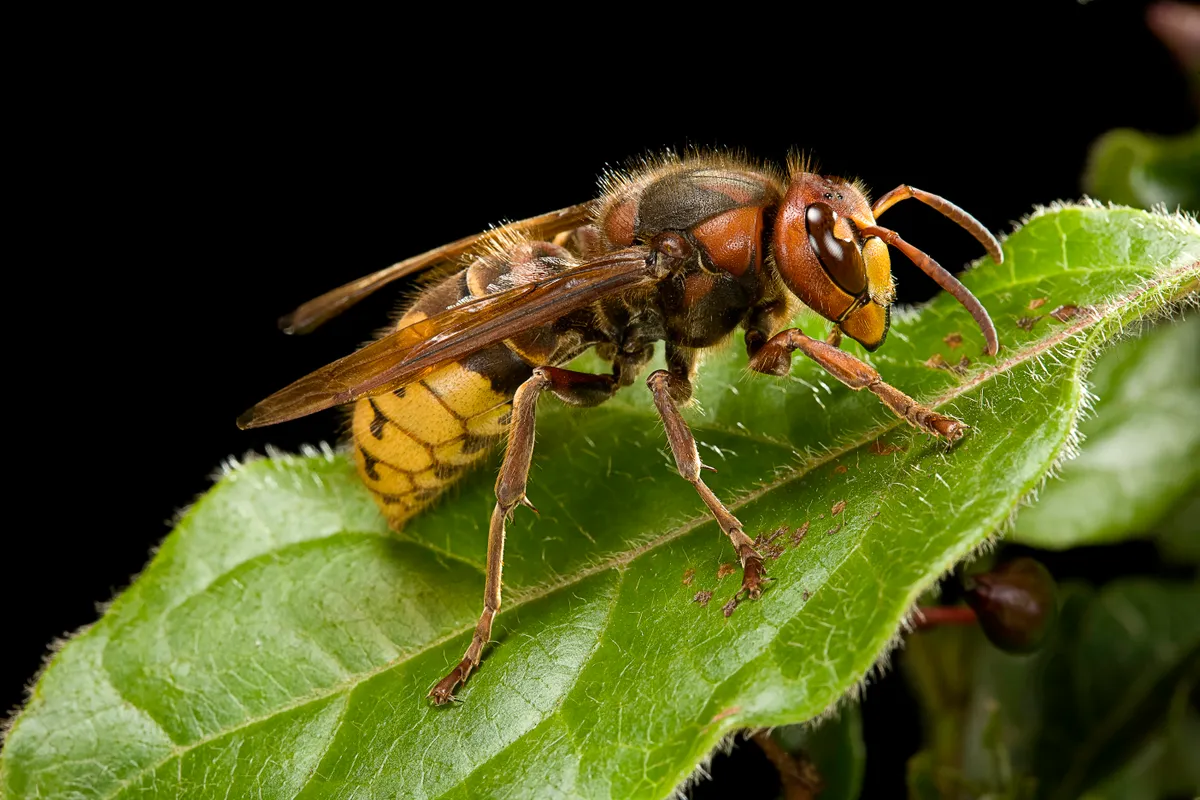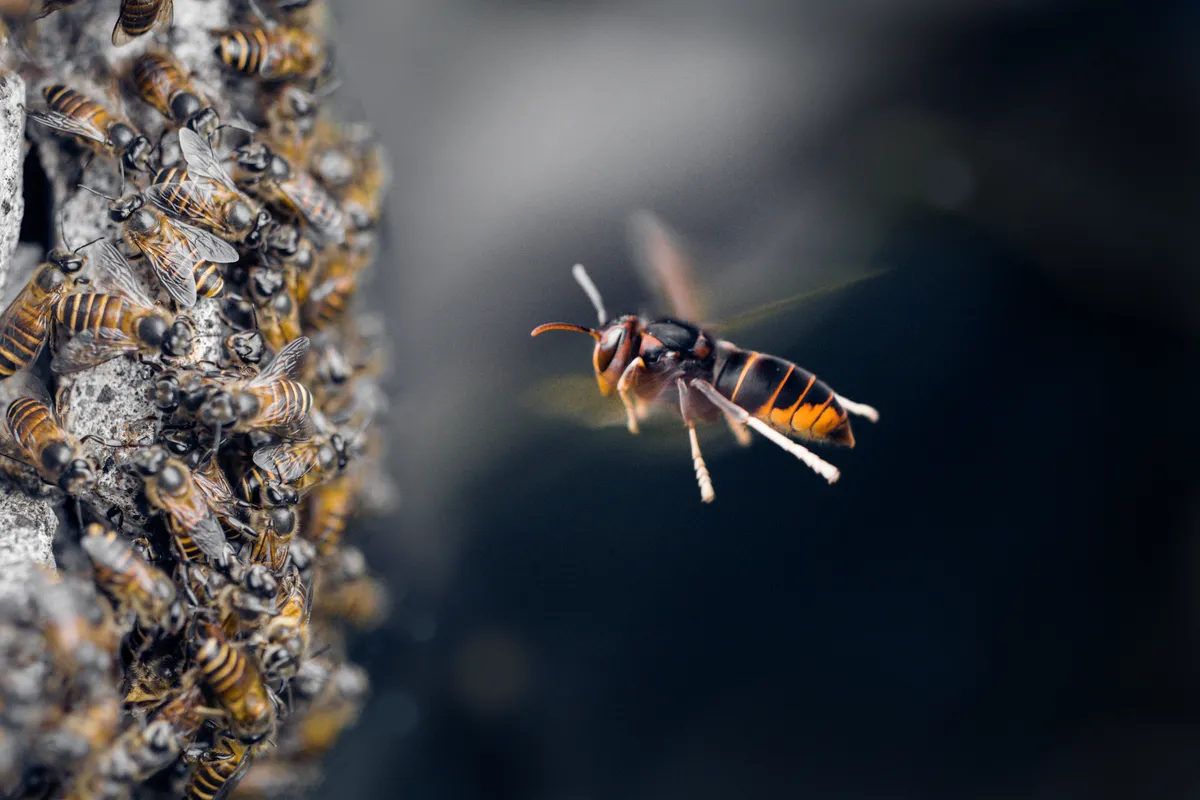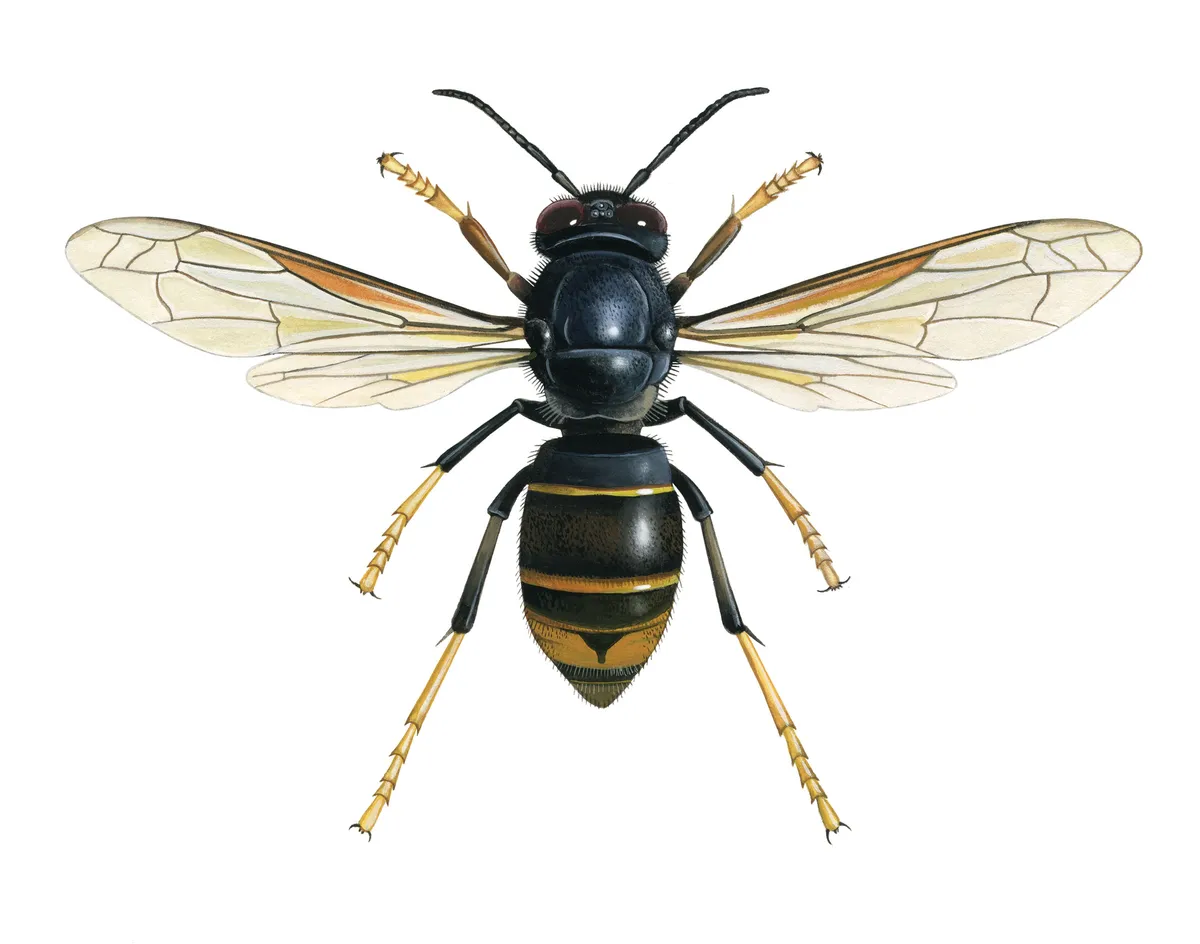Since it was found in Bordeaux in 2004 and started to spread through southern France, the Asian hornet (Vespa velutina) has been a concern to British bee-keepers.
Despite several false alarms over the last couple of years, one of the first confirmed UK sightings was in Tetbury in Gloucestershire in 2016. Dire tabloid warnings have set alarm bells ringing. Should we be worried?
In our expert guide to Asian hornets, Entomologist Richard Jones takes a measured view. Plus, provides advice on how to identify, species facts and why it is important to report a sighting with advice on how to do so.
What do Asian hornet look like?
The Asian hornet, Vespa velutina, is a large social wasp — social because they nest together in colonies, ‘manned’ by large numbers of sterile worker females and controlled by one sexually reproductive egg-laying queen. Workers reach about 25 mm long, queens about 30 mm. The thorax and base of the abdomen are a deep velvety black or dark sooty brown, the tail is orange, the head is black, but with the face deep ochreous orange. The legs are dark brown, fading to yellow at the tips.

How does it compare to the native European hornet?
It is slightly smaller than the European hornet (Vespa crabro) which can reach 28 mm in the workers, 33 mm in the queens. The European hornet is much browner; the thorax and base of the abdomen are a combination of reddish and chocolate browns, the abdomen is more extensively yellow and the head is entirely yellowish orange.

Where do Asian hornets come from?
Originally a native of China, south-east Asia and parts of the Indian subcontinent, Vespa velutina is thought to have arrived in the French port city of Bordeaux in 2004 in a shipment of ceramics. It seems to have spread from China in Korea at a similar time, and arrived in the Japanese island of Tsushima in 2012.
How did it get here?
Once established in southern France, Vespa velutina spread rapidly, south through Spain and Portugal, and north, reaching the Channel Islands (Alderney and Jersey) in July this year. Its arrival in Britain has been long anticipated and entomologists along the south coast have been on tenterhooks. Its appearance well inland in Gloucestershire is something of a surprise, and might imply that it had not flown over of its own accord, but had been accidentally transported in shipped goods of some sort.

Why is the Asian hornet considered a threat?
Like all social wasps, hornets are predators, attacking flies, caterpillars, aphids, bugs or whatever they can get, and feeding the chewed remains to their grubs back in the nest. Asian hornets have a penchant for honeybees and their devastating attacks at French hives are widely reported, with each hornet despatching scores of bees at a time. Though tabloid statistics are not necessarily to be trusted, bee-keepers are not at all happy at anything killing their stock. The hornets are good learners, and if they discover a hive, they settle down to specialise in attacking and killing the ready supply of prey. Asian hornets are just another nuisance bee-keepers have had to deal with after Varroa mites, colony collapse disorder and the fungal disease nosema.
Why isn’t it a problem in Asia?
The western honeybee, Apis mellifera, in Europe is a soft target, bred for high honey production, but also high docility. In the hornet’s native range, the eastern honeybees, Apis cerana, have had a chance to co-evolve with it over many millions of years, and they have a protective strategy to cope. If a hornet attacks the nest, worker honeybees swarm over it. They do not simply try to sting the hornet, which is considerably better armoured than they are. Instead they grapple it to the ground and form a dense scrum around it — up to 240 of them recorded. This balling behaviour focuses the honeybees’ body heat, raising the centre of the ball to around 45ºC; combined with suffocation, this kills the hornet.
How dangerous are Asian hornets? Do they sting humans?
Yes, hornets, like all social wasps (yellow-jackets) have painful stings, but unlike most other wasps, hornets are relatively docile and actually less confrontational. The European hornet already has an ill-deserved reputation for being curmudgeonly and angry, but this is an imagined trait, unfairly put upon the insects because of their large size and slow inquisitive flight. The Asian hornet will sting if picked up, or if its nest is attacked, but it is not regarded as being especially aggressive. Ironically honeybees are probably more likely to attack humans around their nests.
Where do Asian hornets live?
Nests are usually built in trees, in holes, hollows, broken limbs or other tight spaces, but it also makes free-hanging nests, constructed around twigs and small branches in trees and bushes. The horizontal brood combs are covered in a mottled carton made from paper, which the hornets make by chewing wood fibres into a pulp, then smearing on. Nests, about the size of a small rugby ball, usually house a few hundred hornets; this is tiny compared to the social wasps, which can make nests the size of beach balls with perhaps 8000-10,000 individuals at the height of the summer.

How will it spread?
No one yet knows. Britain, an island surrounded by seas, has a cool, damp, oceanic climate, quite different from the continental block climate of France, which has longer hotter summers. Since it is only the mated fertilized queens that survive winter, to found a new nest from scratch the following spring (all other nest occupants die off), the coolness and dampness of this period is a key factor in the insects’ ability to survive or disperse. Coincidentally, the European hornet has been expanding its UK range in the last 30 years, probably as a response to climate change — less ferocious winters during that time.
What can be done about it?
Because of its invasive nature, and its selective predation of honeybees, the Asian hornet is already declared a potential pest in the UK, and measures have been put in place to try and contain and eradicate any colonies that are found. Any potential sightings should be made through the Biological Records centre and GB Non-native species secretariat.
